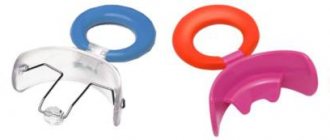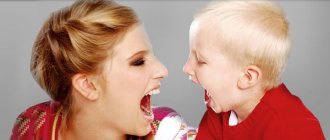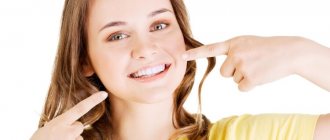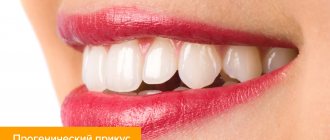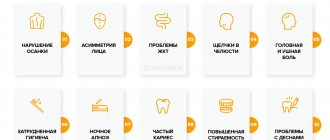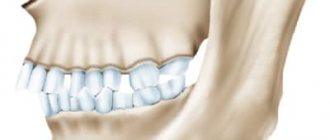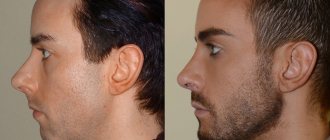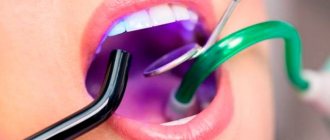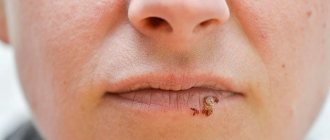An orthodontic pacifier is a pacifier that helps a baby develop a correct bite. Its characteristic feature is the “beveled” edge, due to which the baby’s jaws have to constantly move back and forth to keep the pacifier in the mouth. Because of these movements, the facial muscles actively develop, and the baby calms down much faster (the movements are similar to the sucking reflex during feeding). Unlike regular pacifiers with a round nipple, the orthodontic pacifier fits tightly to the lips, thereby reducing the swallowing of air, which can cause problems with burping or colic.
Pacifiers: harmful to the baby
Prolonged sucking on a pacifier, bottle nipple, or thumb can cause a gap to appear between the front teeth or the development of an open bite, in which the jaws do not close completely.
A pacifier leads to underdevelopment or, on the contrary, too rapid growth of the lower jaw - as a result, it will move forward or be too far relative to the upper jaw.
Also, a bad habit leads to incorrect position of the tongue when swallowing. Normally, the tongue is located at the bottom of the jaw, and not between the front teeth.
Correction of the bite with reliable metal braces - 72,000 rubles.
All inclusive!
Preparation and treatment of the oral cavity, consultation with an orthodontic specialist, installation and adjustment of orthodontic structures. Color options available for little ones! Go to offer>>> Free consultation with an orthodontist +7 (495) 789-39-31 or write to us
The harm and benefits of pacifiers
The sucking reflex is a vital innate human instinct. With its help, the child obtains milk from the mother's breast or bottle. It appears from the 6th month of intrauterine development, so during ultrasound screening you can see how the baby sucks his finger. The intensity of the sucking reflex is different for each baby, and the mother cannot constantly hold her baby at the breast, so almost all parents resort to using a pacifier.
Its use solves several problems at once:
- reducing the baby’s excitability and anxiety due to a decrease in motor activity of the brain;
- eliminating the risk of tongue retraction during sleep.
A pacifier is needed to correct malocclusion in bottle-fed children.
The sucking reflex in a baby gradually fades away by the 8th or 9th month of his life. This is due to the transition to spoon feeding and the further development of the chewing reflex. The sucking instinct completely disappears by 3-4 years. It is during this period that dentists advise contacting them to check whether the pacifier is spoiling the bite of children and whether it is time to wean them off this product.
Dentists note that too active use of a pacifier can create an incorrect bite. The fact is that in a baby, the lower jaw is smaller than the upper jaw. When breastfeeding, the tongue makes wave-like movements, and the lower jaw gradually moves forward.
When using a pacifier, muscle balance is disrupted due to the pressure of the tongue on the jaw line, contraction of the lips and cheek muscles. The load on the mucous membrane increases and the erupting teeth of the upper jaw shift forward. Children who spend 6 or more hours a day with a pacifier are often diagnosed with an open bite, when the teeth of the jaws do not close completely, or a distal bite, when the upper jaw protrudes over the lower jaw. If a child is given a pacifier less often, it will not affect the bite.
Speaking about how the pacifier affects the bite, it should be mentioned that the product also causes problems with diction due to the constant incorrect position of the tongue. When nasal congestion occurs during active pacifier sucking, pressure on the auditory tube increases, which leads to the development of ear diseases. Using a pacifier for too long can cause addiction in your baby. And the older he is, the more difficult it will be to wean him off it. In some babies, attempts to take away the pacifier cause hysterics, leading to psychological trauma.
Some parents tend to blame only the pacifier for malocclusion.
Although pacifier use and occlusion are related, many factors influence the development of the jaw and teeth:
- proper absorption of calcium and phosphorus by the child’s body;
- genetic predisposition to malocclusion;
- mouth breathing;
- head position during feeding.
In order for the bite to form correctly, the baby must be shown to the dentist regularly (every 4 months from the appearance of 8 baby teeth).
Pacifiers for correcting malocclusion
Some manufacturers offer special latex pacifiers that follow the shape of a woman's nipples. They are anatomically correct and allow you to begin to form your bite from birth. These pacifiers should be used before the age of 6 months.
If it is impossible to wean a child from a regular pacifier even after 6 months, if you, as parents, observe the baby’s bad habit of constantly putting something in his mouth, there is a medical, safe alternative - special vestibular plates, also known as pacifiers for correcting malocclusion . These are orthodontic, that is, medical devices.
Thanks to its anatomical shape, the plate allows you to normalize the position of the tongue, reduce its pressure on the front teeth, relieve the masticatory muscles and wean off many bad habits. In addition, it is very easy to accustom your baby to it: they are similar in shape and feel to regular nipples, and also have a bright color - in a playful way, the child will very quickly get used to the new design.
EXPERT OPINION
Ask a question Vagapov Zakir Irkinovich Orthodontist, work experience: 16 years “Orthodontic nipple plates should be used only as prescribed by a doctor, you should not self-medicate: the period of their use can be either permanent or periodic. It all depends on what problem they need to fix. Only based on this, an individual treatment plan, frequency and overall period of wearing orthodontic nipples is formed.”
Recommendations for choosing and using a pacifier
In the first months of a baby's life, he needs a pacifier to satisfy the sucking instinct. And so that this device does not harm the child, it is important to choose it correctly.
- Form. When choosing a pacifier, you need to focus on its anatomical similarity to the female nipple. They create a load on the perioral and facial muscles, and also load the tongue. Preference should be given to orthodontic products. They have the correct anatomical shape with a beveled side, which is used to place the pacifier on the tongue, and a convex side, which is placed towards the palate. This design helps the lower jaw develop correctly.
- Material. Silicone products can withstand high temperatures and can be boiled. They are durable, but not elastic, which increases the likelihood that your baby will chew them as soon as his first teeth appear. Latex nipples are stronger, more elastic and do not put pressure on the gums. But they do not tolerate high temperatures, and they often cause allergies. Bacteria quickly accumulate on the surface of latex products, which means they will have to be replaced frequently.
- Size and number of holes. We should not forget the importance of nipple size for proper bite. Use 1 size for up to six months. Next, the product is changed to size 2. After one and a half years they switch to 3. Foreign manufacturers mark their products with letters (A, B, C). If the nipple is used for bottle feeding, then until the baby is 3 months old, choose a product of size 1 with 1-2 holes. From 3 months to 5 months, nipples with 3 holes are suitable. After 6 months they switch to size 2 with 4 holes.
It is important that it has an air valve, which prevents the baby from swallowing air during feeding.
- The hole in the nipple should not be large. Milk should drip from it, not flow out. Otherwise, the baby will not need to make any effort to extract milk; it will flow on its own. And if the child does not make active sucking movements, the lower jaw will remain in a posterior position and will not grow.
Types of orthodontic pacifiers
- a regular plate for the prevention of malocclusion,
- with a visor, which promotes the development of the lower jaw, as the child bites the visor with his teeth,
- with a bead: with each swallow, the child involuntarily rolls the bead with his tongue, training his muscles,
- with a flap: the flap prevents the tongue from being placed between the front teeth, preventing an open bite,
- a pacifier that exactly follows the shape of a woman’s nipple: used up to 6 months of age.
Varieties
Orthodontic pacifiers vary in shape, size and materials from which they are made.
Based on the material, nipples can be:
- Latex. These nipples are softer than silicone ones and are suitable for premature babies, newborns or children with palatal pathologies. Due to their strength, such nipples are difficult to bite through, so they are not afraid of teething. Disadvantages include: the likelihood of an allergic reaction to latex, poor interaction with high temperatures (loses its shape and “sticks together”), fragility.
- Silicone. Medical silicone is a hypoallergenic material that tolerates high temperatures well, so these pacifiers can be sterilized using hot steam or just boiling water, without the risk of damaging the pacifier. In addition, such nipples do not absorb foreign odors and are durable. The disadvantage of this type of nipple is that it is less durable compared to latex nipples - the baby’s teeth will be able to bite through it.
The shape of the papilla in orthodontic nipples can be regular or figured - in the form of a “heart” and “cherry”. The choice of a specific model depends on the taste preferences of the parents.
Nipple sizes
There are three categories of nipples depending on the age of the baby (and the size of his mouth):
- Category A - from 1 to 6 months;
- Category B - from 6 to 12 months;
- Category C - from 1 year and older.
There are separate pacifiers for premature babies, newborns and babies with pathologies of the oral cavity structure.
As the child grows, the pacifier model must be changed to an appropriate one, otherwise the process of bite formation will be disrupted.
The benefits of pacifiers for correcting malocclusion
- formation of the correct bite,
- normalization of jaw position,
- no allergic reactions: nipples are made from hypoallergenic materials using modern equipment,
- supporting the tongue in a natural position - reducing its pressure on the front teeth,
- protection against the appearance of open bite, gaps between the front teeth, upper and lower jaws,
- formation of the correct swallowing reflex,
- development of normal nasal breathing,
- getting rid of bad habits such as thumb or pacifier sucking.
The ease of use of orthodontic pacifiers makes them as useful and comfortable as possible for both parents and children. Their use helps prevent the formation of bad habits that have a detrimental effect on the development of the baby’s bite.
Ceramic braces In-Ovation C — RUB 76,500!
All inclusive! Preparation and treatment of the oral cavity, consultation with an orthodontic specialist, installation and adjustment of orthodontic structures. The price is for 1 jaw. Read about the promotion>>> Consultation with a doctor is free! Call now: +7 (495) 789-39-31
Malocclusions can cause problems with appearance and posture, provoke respiratory and digestive disorders, and impair diction. Not only orthodontic plates will help you avoid all this, but also maximum attention to the child’s health and, of course, parental love!
Price
| Service name | Price |
| SmartСlip self-ligating (Germany) | 67,000 rub. |
| Minimaster ligatures (USA) | RUB 59,400 |
All prices for services
Features of use
An orthodontic nipple, unlike a regular one, has an “upper” and “lower” side - a beveled, shorter edge that should be adjacent to the tongue. At first, while the baby gets used to the pacifier, you need to make sure that he takes it correctly.
Important! If the pacifier falls or gets dirty, it must be washed with soap (for this you should use hypoallergenic baby soap that does not contain aggressive chemicals), and then sterilized using hot steam or boiling water. High-temperature sterilization is not suitable for latex pacifiers, so an antibacterial detergent must be used.
If the pacifier loses its shape or cracks appear on it, it should no longer be used, since the microbes that get inside are not destroyed during sterilization and enter the child’s body.
The pacifier is a psychological factor that causes addiction. Therefore, you should not “correct” a pacifier that has fallen out during sleep, nor should you give it every time the child makes at least some sound. After a year, it is advisable to gradually wean your baby off the pacifier.
When breastfeeding, there is no need for a pacifier at all for the first few months of life. If the child is artificially fed, then the orthodontic pacifier helps to form a correct bite and compensate for the lack of sucking movements necessary for natural feeding.

